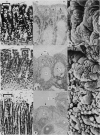Abstract
A single pass perfusion system was used in anaesthetised, restrained rats to examine the effect of changing the composition of the perfusion fluid on the damage caused to the colonic epithelium by deoxycholic acid. Damage to the colonic surface was monitored with light microscopy, transmission and scanning electron microscopy and with measurements of deoxyribonucleic acid and carbohydrate in the perfusate. New scoring techniques for monitoring alterations in surface epithelium of light microscopy sections were used. The damaging effect of 5 mM deoxycholic acid to the colonic epithelium is inhibited by lowering the pH of the perfusion fluid from 7.9 to 5.5, or by increasing the calcium concentration from 0 to 4 mM. This inhibition is shown to be because of a decreased amount of bile acid in solution. Thus it is not the total concentration of deoxycholic acid in the colon that is responsible for the colonic damage, but the concentration in solution. Although extrapolation to the human situation must be made with caution, the concentration of bile acid in solution in the faecal water may be more relevant to colonic mucosal damage than total bile acid concentration.
Full text
PDF









Images in this article
Selected References
These references are in PubMed. This may not be the complete list of references from this article.
- Breuer N. F., Rampton D. S., Tammar A., Murphy G. M., Dowling R. H. Effect of colonic perfusion with sulfated and nonsulfated bile acids on mucosal structure and function in the rat. Gastroenterology. 1983 May;84(5 Pt 1):969–977. [PubMed] [Google Scholar]
- Chadwick V. S., Gaginella T. S., Carlson G. L., Debongnie J. C., Phillips S. F., Hofmann A. F. Effect of molecular structure on bile acid-induced alterations in absorptive function, permeability, and morphology in the perfused rabbit colon. J Lab Clin Med. 1979 Nov;94(5):661–674. [PubMed] [Google Scholar]
- Gaginella T. S., Chadwick V. S., Debongnie J. C., Lewis J. C., Phillips S. F. Perfusion of rabbit colon with ricinoleic acid: dose-related mucosal injury, fluid secretion, and increased permeability. Gastroenterology. 1977 Jul;73(1):95–101. [PubMed] [Google Scholar]
- Goerg K. J., Specht W., Nell G., Rummel W., Schulz L. Effect of deoxycholate on the perfused rat colon. Scanning and transmission electron microscopic study of the morphological alterations occurring during the secretagogue action of deoxycholate. Digestion. 1982;25(3):145–154. doi: 10.1159/000198823. [DOI] [PubMed] [Google Scholar]
- Hill M., MacLennan R., Newcombe K. Diet and large-bowel cancer in three socioeconomic groups in Hong Kong. Lancet. 1979 Feb 24;1(8113):436–436. doi: 10.1016/s0140-6736(79)90905-x. [DOI] [PubMed] [Google Scholar]
- Hofmann A. F., Poley J. R. Role of bile acid malabsorption in pathogenesis of diarrhea and steatorrhea in patients with ileal resection. I. Response to cholestyramine or replacement of dietary long chain triglyceride by medium chain triglyceride. Gastroenterology. 1972 May;62(5):918–934. [PubMed] [Google Scholar]
- McJunkin B., Fromm H., Sarva R. P., Amin P. Factors in the mechanism of diarrhea in bile acid malabsorption: fecal pH--a key determinant. Gastroenterology. 1981 Jun;80(6):1454–1464. [PubMed] [Google Scholar]
- Mekjian H. S., Phillips S. F., Hofmann A. F. Colonic secretion of water and electrolytes induced by bile acids: perfusion studies in man. J Clin Invest. 1971 Aug;50(8):1569–1577. doi: 10.1172/JCI106644. [DOI] [PMC free article] [PubMed] [Google Scholar]
- Mudd D. G., McKelvey S. T., Norwood W., Elmore D. T., Roy A. D. Faecal bile acid concentration of patients with carcinoma or increased risk of carcinoma in the large bowel. Gut. 1980 Jul;21(7):587–590. doi: 10.1136/gut.21.7.587. [DOI] [PMC free article] [PubMed] [Google Scholar]
- Palmer R. H. Bile acid heterogeneity and the gastrointestinal epithelium: from diarrhea to colon cancer. J Lab Clin Med. 1979 Nov;94(5):655–660. [PubMed] [Google Scholar]
- Prasad A. S., DuMouchelle E., Koniuch D., Oberleas D. A simple fluorometric method for the determination of RNA and DNA in tissues. J Lab Clin Med. 1972 Oct;80(4):598–602. [PubMed] [Google Scholar]
- Rampton D. S., Breuer N. F., Vaja S. G., Sladen G. E., Dowling R. H. Role of prostaglandins in bile salt-induced changes in rat colonic structure and function. Clin Sci (Lond) 1981 Nov;61(5):641–648. doi: 10.1042/cs0610641. [DOI] [PubMed] [Google Scholar]
- Saunders D. R., Hedges J. R., Sillery J., Esther L., Matsumura K., Rubin C. E. Morphological and functional effects of bile salts on rat colon. Gastroenterology. 1975 May;68(5 Pt 1):1236–1245. [PubMed] [Google Scholar]
- Tadayyon B., Lutwak L. Interrelationship of triglycerides with calcium, magnesium and phosphorus in the rat. J Nutr. 1969 Feb;97(2):246–254. doi: 10.1093/jn/97.2.246. [DOI] [PubMed] [Google Scholar]
- Vernia P., Breuer R. I., Gnaedinger A., Latella G., Santoro M. L. Composition of fecal water. Comparison of "in vitro" dialysis with ultrafiltration. Gastroenterology. 1984 Jun;86(6):1557–1561. [PubMed] [Google Scholar]
- Wargovich M. J., Eng V. W., Newmark H. L., Bruce W. R. Calcium ameliorates the toxic effect of deoxycholic acid on colonic epithelium. Carcinogenesis. 1983 Sep;4(9):1205–1207. doi: 10.1093/carcin/4.9.1205. [DOI] [PubMed] [Google Scholar]
- Wargovich M. J., Eng V. W., Newmark H. L. Calcium inhibits the damaging and compensatory proliferative effects of fatty acids on mouse colon epithelium. Cancer Lett. 1984 Jul;23(3):253–258. doi: 10.1016/0304-3835(84)90091-0. [DOI] [PubMed] [Google Scholar]
- de Wael J., Raaymakers C. E., Endeman H. J. Simplified quantitative determination of total fecal bile acids. Clin Chim Acta. 1977 Sep 1;79(2):465–470. doi: 10.1016/0009-8981(77)90443-0. [DOI] [PubMed] [Google Scholar]



